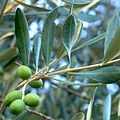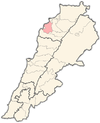Darbechtar
| Darbechtar داربعشتار | |
|---|---|
| Village | |
 | |
 Darbechtar | |
| Coordinates: 34°16′06″N 35°47′37″E / 34.26833°N 35.79361°ECoordinates: 34°16′06″N 35°47′37″E / 34.26833°N 35.79361°E | |
| Country |
|
| Governorate | North Governorate |
| District | Koura District |
| Elevation | 300 m (1,000 ft) |
| Time zone | EET (UTC+2) |
| • Summer (DST) | EEST (UTC+3) |
| Dialing code | +961 |
Darbechtar ( known also as Darb Ishtar, Arabic: داربعشتار) is a village located on the South-Eastern periphery of the Koura District in the North Governorate of the Republic of Lebanon.
Darbechtar borders the villages of Amyoun, Bziza, Majdel, Kaftoun, and Dar-shmizzine.
The Lebanese hailing from Darbechtar number 10,000 worldwide. 85% of them live outside Lebanon, mainly in Brazil, Argentina, Australia, Canada and the United States.
The population of Darbechtar is Maronite Catholic.
Etymology
The name of the village is derivative of the Aramaic words, Dar and Ishtar, meaning the House of Astarte. It is believed that the village was the site of an ancient Phoenician shrine for the Goddess of Fertility.
Climate
Darbechtar : Mediterranean plain village with heavy rains, mild winters and hot dry arid summers.
Min / Max average temperatures in Celsius Degree
Jan (8/16) Feb (9/16) Mar (10/19) Apr (13/22) May (16/25) Jun (19/27) Jul (22/29) Aug (23/30) Sep (20/29) Oct (17/27) Nov (13/22) Dec (10/18)
Environment
The village is the home of Olive oil production. Therefore most of the village is planted with the ever green Olive Trees along with Grapes, Figs, variety of bushes, plants, and flowers.
Description of the Olive Tree
The Olive is an evergreen tree or shrub native to the Mediterranean. It is short and squat, and rarely exceeds 8-15 meters in height.
The silvery green leaves are oblong in shape, measuring 4–10 cm long and 1–3 cm wide. The trunk is typically gnarled and twisted.
The small white flowers, with four-cleft calyx and corolla, two stamens and bifid stigma, are borne generally on the last year's wood, in racemes springing from the axils of the leaves.
The fruit is a small drupe 1-2.5 cm long, thinner-fleshed and smaller in wild plants than in orchard cultivars. Olives are harvested at the green stage or left to ripen to a rich purple color(black olive).
Olive oil extraction
Traditionally, olive oil was produced by crushing olives in stone or wooden mortars or beam presses. Nowadays, olives are ground to tiny bits, obtaining a paste that is mixed with water and processed by a centrifuge, which extracts the oil from the paste, leaving behind pomace.
Uses of the Olive Fruit
Olive Oil is used in cooking, cosmetics, pharmaceuticals, and soaps, and as a fuel for traditional oil lamps. Olive oil is a healthful oil because of its high content of monounsaturated fat (mainly oleic acid) and polyphenols.
Places of worship
There are 4 places of Christian worship in Darbechtar mainly Churches:
- Church of Saint George
- Church of Saint Elias
- Church of Saint Chalita
- Church of our Lady of Saydeh
Photo gallery
-

View of Darbechtar.
-

This is the Church of St. Georges.
-

This is the interior of the Church of St. Georges.
-

This is the Church of Saydeh.
-

This is the interior of the Church of Saydeh.
-

This is the way leading to the Cave of St. Elias.
-

This is the Cave of St. Elias.
-

This is the Valley of St. Elias. The Cave of St. Elias is located in this Valley.
-

This is the Church of Mar Chalita.
-

Naher el Asfour.
-

Naher el Asfour.
-

You can find a spring water outlet below ground level.
-
Delicious Grapes.
-

The Olive Fruit.
-
Green Olive Tree Field.
-

The Olive Fruit.
-

The Olive Fruit Harvest.


